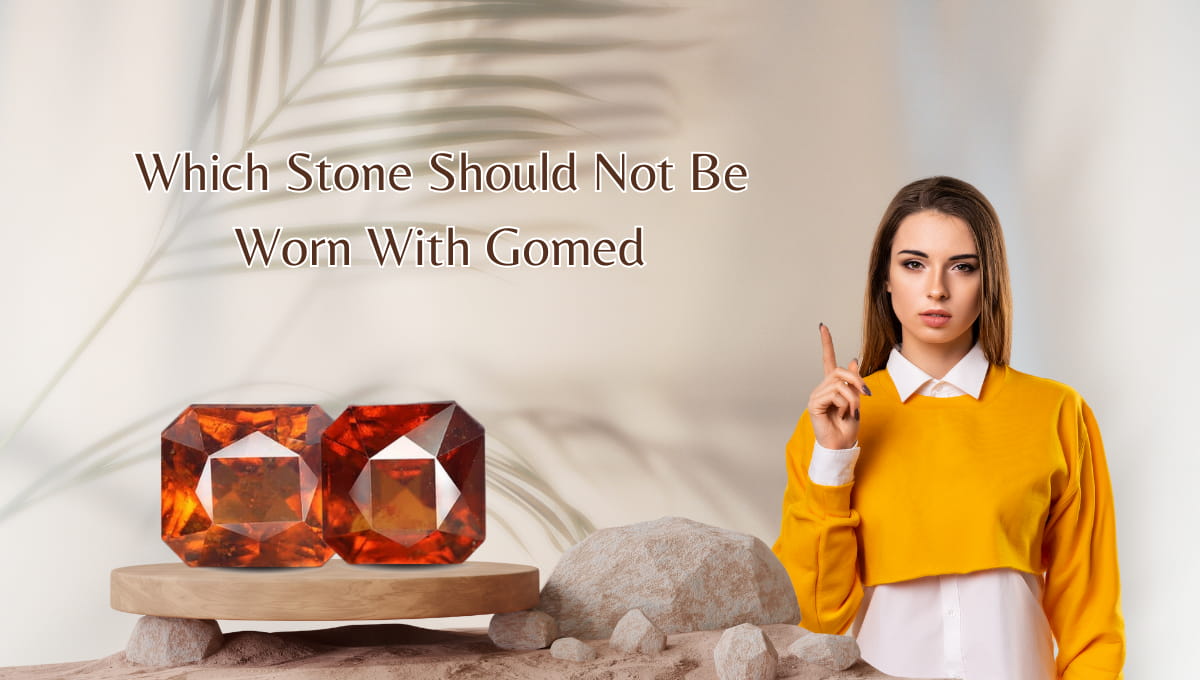In the intriguing world of gemology and astrological beliefs, the choice of wearing a particular gemstone is not merely a matter of personal taste but often involves a delicate interplay of cosmic energies and ancient wisdom. Among these, Gomed, also known as Hessonite, holds a special place, revered for its astrological significance and potent influence according to Vedic astrology. This intriguing gem, associated with the celestial planet Rahu, is believed to have profound impacts on an individual’s life, bestowing power, wealth, and unexpected success.
However, the cosmic interplay does not favor all combinations, and there are specific gemstones that, when worn alongside Gomed stone, can disrupt its harmonious vibrations and lead to undesirable consequences. This blog post delves into the fascinating reasons behind these incompatibilities, uncovering which stones should not be paired with Gomed and exploring the ancient wisdom that guides these principles. Through understanding these cosmic relationships, one can make informed decisions to harmonize their astrological influences and harness the full potential of their gemstones.
Understanding Hessonite (Gomed) Stone First
Understanding the Gomed stone, also known as Hessonite, requires delving into the realms of gemology, astrology, and ancient beliefs. Gomed is a type of garnet that is primarily reddish-brown to orange-brown in color and is associated with the planet Rahu in Vedic astrology. This association makes Gomed a highly sought-after gemstone for its believed astrological benefits.
Don’t Miss: – How to Wear Gomed
According to Vedic astrology, Rahu is a shadow planet that holds significant influence over one’s destiny, ambitions, and material desires. Gomed is believed to harness the energies of Rahu, thereby enhancing one’s ability to achieve success, wealth, and power. It is often recommended for individuals who seek to overcome obstacles, excel in their careers, and attain financial prosperity.
One of the distinctive features of Gomed is its ability to counter the malefic effects of Rahu in a person’s horoscope. It is said to bring clarity of thought, improve decision-making abilities, and promote stability in tumultuous times. Additionally, Gomed is associated with the root chakra, enhancing grounding, stability, and strength.
In terms of physical properties, Gomed is a durable gemstone with a vitreous luster and excellent clarity. Its distinctive coloration and unique internal characteristics make it a captivating choice for jewelry enthusiasts and believers in astrology alike.
Gemstones That Should Not Be Worn With Gomed
While the warm, golden hues of GomEd stone make it a popular choice for jewelry and accessories, it’s crucial to be mindful of the gemstones you pair it with. Certain stones can react with GomEd, leading to discoloration, fading, or even potential damage. To preserve the beauty and integrity of your GomEd pieces, it’s recommended to avoid wearing the following stones with GomEd:
Opaque Gemstones Opaque gemstones like turquoise, lapis lazuli, and malachite should be avoided when wearing GomEd stone. These stones contain copper, which can react with the iron and other trace minerals present in GomEd, causing discoloration or staining.
Iron-rich Stones Stones with a high iron content, such as hematite, pyrite, and smoky quartz, can interact with the iron present in GomEd stone, leading to potential discoloration or oxidation.
Also Read: – Who Should Wear Gomed
Porous Stones Porous stones like natural pearls, coral stones, and certain types of jade should not be worn with GomEd stone. These stones can absorb oils, sweat, and other substances from the skin, which may transfer to the GomEd and cause discoloration or staining.
Soft Stones Soft gemstones like original opal stone, amber, and tanzanite should be kept away from GomEd stone. The abrasive nature of GomEd can potentially scratch or damage these delicate stones.
Dyed Stones Avoid wearing dyed gemstones, such as dyed quartz or dyed jade, with GomEd stone. The dyes used in these stones can bleed or transfer onto the GomEd, causing discoloration or staining.
Instead, it’s recommended to pair Gomed stone with gemstones that are non-porous, hard, and chemically stable. Some suitable options include diamonds, rubies, sapphires, and certain types of quartz (e.g., amethyst, citrine). These stones are less likely to react with GomEd and can complement its warm tones beautifully.
Additionally, it’s advisable to remove Gomed jewelry when applying perfumes, lotions, or other cosmetic products, as these substances can potentially cause discoloration or damage to the stone.
By being mindful of the stones you pair with Gomed and taking proper care, you can ensure that your Gomed pieces retain their natural beauty and luster for years to come.
Check Out: – Substitutes of Hessonite
